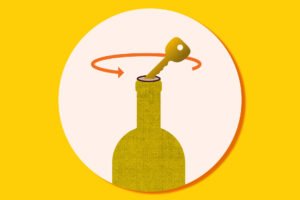Calls for Napa to Relocate Landfill

[ad_1]
A local mayor wants Napa’s county dump to close before disaster strikes.
By W. Blake Gray | Posted Friday, 26-Nov-2021
Looking at an aerial photo of the Clover Flat Landfill, it’s easy to see why Napa County leaders thought, in the late 1950s, that it would be a great place to put the county’s garbage.
It’s a stunning location: it may have the best view of any landfill in the country. It’s nestled at the top of a mountain in the Palisades range, high above the town of Calistoga. Storing garbage on an out-of-the way mountaintop, surrounded by forest – what could go wrong? The landfill opened in 1963 and most of northern Napa Valley’s garbage has gone there ever since. Napa County had planned to close it in 2002, but recycling efforts extended the life of the facility, according to a history of the landfill released by the county.
Fast forward to 2021. We know more about the environment now; we know that the mountain is at the top of the watershed that leads into the Napa River. We also know that being surrounded by forest in contemporary California means fire risk.
You might think that Napa County would reconsider where the landfill should be. But the governing body in charge – the Upper Valley Waste Management Agency – instead decided in October 2020 to remove the landfill’s service boundaries. Previously it was restricted to accepting garbage from northern Napa County; it can now accept garbage from anywhere. And its contract runs through 2047.
Already this year, the landfill is taking in six times as much garbage as previously, according to St Helena Mayor Geoff Ellsworth, who says he has seen trucks from Sonoma County, and wonders how wide the landfill’s customer base is now.
“That’s six times the contamination load, and six times the methane load,” Ellsworth told Wine-Searcher. “Why are we bringing in huge amounts of garbage into this small delicate valley?”
Ellsworth is a crusader against the landfill and another dump run by the same company, Upper Valley Disposal Recycling on Whitehall Lane. He has lived in St Helena since 1969 and was involved in the environmental movement before running for mayor and winning in 2018. Since then, he has used his position to attend meetings around the county, often with a disclaimer like the one on his emails that his views are his own and do not represent the city of St Helena.
Personal crusade
Some fellow Napa citizens agree with him, while others are wary of his activism. Earlier this year, a group of residents who live next to Upper Valley Disposal Services filed a lawsuit against the facility, complaining about the noise and smell. In its response to the lawsuit, the company said that the neighbors were trying to get information on UVDS’ operations as part of Ellsworth’s “personal vendetta” against the company. UVDS also claimed that Ellsworth and its facility’s neighbors are trying to “put financial pressure on the companies” and “create bad press for the companies”.
The neighbors have since withdrawn that lawsuit and are now suing the government agency that approved the contracts. Echoing Ellsworth’s main complaint, they say the agency should have allowed competitive bidding so that other companies could have presented other plans. I spoke to Sandi Thompson, one of the plaintiffs in the lawsuit. The problematic location of Clover Flat Landfill I understand, but regarding UVDS, which is on flatlands and not surrounded by forest, doesn’t the county have a need for a garbage dump somewhere?
“Of course there is,” Thompson said. “But no one has ever looked at the alternatives. That’s part of the fiduciary responsibility the county has, to look at other bids. That’s their duty to us. They have a responsibility to the people of Napa County to make sure our water and air are safe.”

© Brian Lilla
| PFAs – co-called “forever chemicals” have been found in groundwater and leachate samples.
Both Clover Flat Landfill and UVDS are owned by the Pestoni family, who also own Pestoni Family Winery. I would love to give the Pestonis’ side of the story, but the company representative who responded to my phone calls, emails and texts promised on two separate days to call me in the afternoon – which I left wide open both times – and never did.
I did, however, receive a mildly threatening phone call from a longtime professional wine source (NOT the Pestonis) when I started working on this story. I was warned to be “very very careful about working with those people” – Ellsworth and other environmentalists. I explained that as mayor, he has a platform, and that I would write this story because of it. This is how personally associated Ellsworth has become with the issue: He’s a guy making noise about a topic that most would prefer to be quiet.
There’s an obvious reason that Napa wine people don’t want this to become a topic of discussion. In May 2020, at the request of the San Francisco Bay Regional Water Quality Control Board, groundwater at the landfill was tested for PFAs – Per- and Polyfluoroalkyl Substances, nicknamed “forever chemicals” because they break down very slowly. They came into existence when Teflon was introduced in 1946, and they have been found in public drinking-water systems in 49 states.
The Environmental Protection Agency’s official website says of PFAs: “PFAS are found in water, air, fish, and soil at locations across the nation and the globe,” and also: “Scientific studies have shown that exposure to some PFAs in the environment may be linked to harmful health effects in humans and animals.” The May 2020 tests showed that PFAs are in all of the groundwater samples taken at Clover Flat Landfill, as well as all of the “leachate” samples. Leachate is liquid that contains dissolved solids; dealing with leachate is one of the main environmental challenges of every landfill. The upshot is, PFAs can be found in the landfill at the head of the watershed for the most prized vineyards in North America. No wonder people don’t want to talk about it.
“We’ve got forever chemicals in Napa in the watershed?” Thompson said. “If you are taking that water and putting it on your grapes, are you really organic?”
I reached out to Napa Valley Vintners for a quote but they declined to comment.
No comment
“Napa Valley Vintners are turning and looking the other way,” Ellsworth said. “I’m hopeful the Napa Valley Vintners will engage on the waste site issues here as they relate to water contamination risks, wildfire risks and climate impacts in our small geographic valley. Risks and impacts that can affect both our community and our Napa Valley brand.”
Last year, Wine-Searcher did a story about a series of problems at the Clover Flat Landfill, including 13 times the landfill caught fire on its own since 2013, a release of contaminated water into a Napa River tributary, and improperly handled radioactive materials that led one worker to be hospitalized.
The Napa Register newspaper has done most of the work of reporting on the landfill over the years; our story drew heavily from it. In July of this year, a reporter took a publicity tour of the landfill to report on improvements made there. The Register story says that the “Pestoni family went to court in 2019 to wrest control of the company away from founder Bob Pestoni. His daughter, Chief Operating Officer Christy Pestoni, brought in a new management team led by people who previously worked for larger companies like Waste Management.” The article is generally complimentary about changes made by Christy Pestoni, a striking change in tone for the Register.
Even Ellsworth says: “The management change from the father to the daughter, they have definitely put some effort into cleaning things up. I maintain that the problem is the location, no matter what they do. By keeping this location, you’re putting everyone at risk from the water and the fires. Landfills are inherently prone to fire. It’s the nature of landfills. Why would we take this risk if we don’t have to?”
Ellsworth’s obsession is to see the contract opened up for competitive bidding.
“In most cases I’m an advocate for smaller business, but for waste management, we have an obligation to use best practices,” Ellsworth said. “Companies can come in for competitive bidding, and they put out plans for how they manage waste. Larger companies like Recology or whoever it is, they have economies of scale. They manage waste in ways that have divergent streams, so less waste goes into the landfills. We haven’t had competitive bidding for 60 years. Everybody’s winery, they’re looking for innovative solutions. But for waste management, we’ve trusted one company for 60 years and if you look at their track record, it’s atrocious.”
But as it is now, Clover Flat Landfill can continue to take in garbage for a fee, from anywhere.
With its fine wines, great restaurants and beautiful scenery, Napa Valley is a magnet for tourism. For the next 26 years, it might also be a magnet for garbage.
[ad_2]




